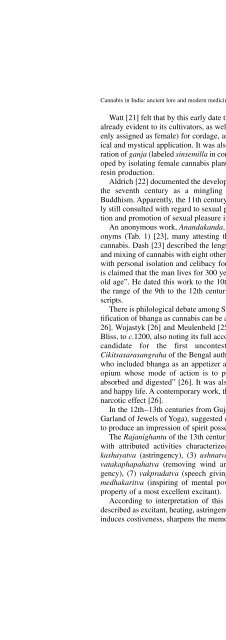3. Umbruch 4.4..2005 - Online Pot
3. Umbruch 4.4..2005 - Online Pot
3. Umbruch 4.4..2005 - Online Pot
Create successful ePaper yourself
Turn your PDF publications into a flip-book with our unique Google optimized e-Paper software.
Cannabis in India: ancient lore and modern medicine 3<br />
Watt [21] felt that by this early date the sexual dimorphism of cannabis was<br />
already evident to its cultivators, as well as the superiority of bhanga (mistakenly<br />
assigned as female) for cordage, and bhang (mistaken as male) for medical<br />
and mystical application. It was also likely about this time that the preparation<br />
of ganja (labeled sinsemilla in contemporary North America) was developed<br />
by isolating female cannabis plants to prevent fertilization, and increase<br />
resin production.<br />
Aldrich [22] documented the development of tantric cannabis usage around<br />
the seventh century as a mingling of Shaivite Hinduism and Tibetan<br />
Buddhism. Apparently, the 11th century text, Mahanirvana Tantra, is currently<br />
still consulted with regard to sexual practices, withholding of male ejaculation<br />
and promotion of sexual pleasure in both genders.<br />
An anonymous work, Anandakanda, added some 43 Sanskrit cannabis synonyms<br />
(Tab. 1) [23], many attesting the remarkable rejuvenating effects of<br />
cannabis. Dash [23] described the lengthy methods of cultivation, processing<br />
and mixing of cannabis with eight other medicinal plants, that when combined<br />
with personal isolation and celibacy for 3 years produce a result in which “it<br />
is claimed that the man lives for 300 years free from any disease and signs of<br />
old age”. He dated this work to the 10th century, while Rao [24] placed it in<br />
the range of the 9th to the 12th centuries, and noted some 10 known manuscripts.<br />
There is philological debate among Sanskrit scholars as to whether the identification<br />
of bhanga as cannabis can be authenticated before the year 1000 [25,<br />
26]. Wujastyk [26] and Meulenbeld [25] dated the Anandakanda, or Root of<br />
Bliss, to c.1200, also noting its full accounting of cannabis’ side effects. Their<br />
candidate for the first uncontested source for cannabis is the<br />
Cikitsasarasangraha of the Bengal author Vangasena, in the late 11th century,<br />
who included bhanga as an appetizer and digestive, noting it as “a drug like<br />
opium whose mode of action is to pervade the whole body before being<br />
absorbed and digested” [26]. It was also suggested in two recipes for a long<br />
and happy life. A contemporary work, the Dhanvantariyanighantu, observed a<br />
narcotic effect [26].<br />
In the 12th–13th centuries from Gujarat, Nagarjuna’s Yogaratnamala (The<br />
Garland of Jewels of Yoga), suggested cannabis smoke as a method by which<br />
to produce an impression of spirit possession in one’s enemies [26].<br />
The Rajanighantu of the 13th century added additional synonyms (Tab. 1),<br />
with attributed activities characterized as [18] (1) katutva (acridity), (2)<br />
kashayatva (astringency), (3) ushnatva (heat), (4) tiktatva (pungency), (5)<br />
vatakaphapahatva (removing wind and phlegm), (6) samgrdhitva (astringency),<br />
(7) vakpradatva (speech giving), (8) balyatva (strength-giving), (9)<br />
medhakaritva (inspiring of mental power) and (10) sreshthadipanatva (the<br />
property of a most excellent excitant).<br />
According to interpretation of this source [27], “Its effects on man are<br />
described as excitant, heating, astringent; it destroys phlegm, expels flatulence,<br />
induces costiveness, sharpens the memory, excites appetite, etc.”







